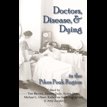Doctors, Disease, and Dying in the Pikes Peak Region
Doctors, Disease, and Dying in the Pikes Peak Region
€ 5,31
A quote attributed to Mark Twain says, “Be careful about reading health books. You may die of a misprint.” While there is no evidence that Mark Twain truly uttered, or wrote, this quip, the readers of this book are fortunate—it does not make any health recommendations. And although the odds are very good that you will die, it is nearly certain that reading this book will not be the cause.
Readers will, however, engage in a journey through the Pikes Peak region’s fascinating, and often tragic, history of disease and death, and along the way will learn of the heroic women and men who dedicated their lives to healing in our community. Doctors, Disease, and Dying in the Pikes Peak Region is a tribute to these people.
Readers will learn about some of the formidable health challenges of our region, challenges often overcome by advancements in medical science; about the early development of health care as a thriving industry; and about the scientists, doctors, nurses, and other concerned professionals who have led the cause for a better quality of life in the Pikes Peak area. Among the causes of death discussed in the book, readers will learn about combat, disease, injury, murder, and many other forms of demise.
Doctors, Disease, and Dying in the Pikes Peak Region includes tales of the pioneers, traders, and military personnel who were both the purveyors and the recipients of needed care. There are chapters about the women and men who practiced medicine in this region, discussions about internationally significant developments for the treatment of tuberculosis and cancer, the impacts of
epidemics on the community, mental health issues, and poverty.
Tuberculosis treatment became a booming business in the region during the late 19th century. Many care facilities welcomed “invalids” from elsewhere, and “lungers” who had the means to be treated to resort living. Though the
words “sanitarium” and “sanatorium” often were used interchangeably in the names of the treatment centers, the editors of this book have chosen to use the word “sanatorium,” which according to the October 1910 issue of American Medicine was defined as “an institution for treatment of disease or care of invalids; especially an establishment employing natural therapeutic agents or conditions peculiar to the locality.”
The climate of the Pikes Peak region, the therapeutic mineral waters of Manitou Springs, and, most of all, the talented medical professionals who practiced here, all combined to form a healthful place to live. A quote we
can attribute—to Jody Jones, regional history specialist in Special Collections—affirms, “Tuberculosis patients came to the Pikes Peak region to get well, not to die.”
May you enjoy reading this in good health.
A quote attributed to Mark Twain says, “Be careful about reading health books. You may die of a misprint.” While there is no evidence that Mark Twain truly uttered, or wrote, this quip, the readers of this book are fortunate—it does not make any health recommendations. And although the odds are very good that you will die, it is nearly certain that reading this book will not be the cause.
Readers will, however, engage in a journey through the Pikes Peak region’s fascinating, and often tragic, history of disease and death, and along the way will learn of the heroic women and men who dedicated their lives to healing in our community. Doctors, Disease, and Dying in the Pikes Peak Region is a tribute to these people.
Readers will learn about some of the formidable health challenges of our region, challenges often overcome by advancements in medical science; about the early development of health care as a thriving industry; and about the scientists, doctors, nurses, and other concerned professionals who have led the cause for a better quality of life in the Pikes Peak area. Among the causes of death discussed in the book, readers will learn about combat, disease, injury, murder, and many other forms of demise.
Doctors, Disease, and Dying in the Pikes Peak Region includes tales of the pioneers, traders, and military personnel who were both the purveyors and the recipients of needed care. There are chapters about the women and men who practiced medicine in this region, discussions about internationally significant developments for the treatment of tuberculosis and cancer, the impacts of
epidemics on the community, mental health issues, and poverty.
Tuberculosis treatment became a booming business in the region during the late 19th century. Many care facilities welcomed “invalids” from elsewhere, and “lungers” who had the means to be treated to resort living. Though the
words “sanitarium” and “sanatorium” often were used interchangeably in the names of the treatment centers, the editors of this book have chosen to use the word “sanatorium,” which according to the October 1910 issue of American Medicine was defined as “an institution for treatment of disease or care of invalids; especially an establishment employing natural therapeutic agents or conditions peculiar to the locality.”
The climate of the Pikes Peak region, the therapeutic mineral waters of Manitou Springs, and, most of all, the talented medical professionals who practiced here, all combined to form a healthful place to live. A quote we
can attribute—to Jody Jones, regional history specialist in Special Collections—affirms, “Tuberculosis patients came to the Pikes Peak region to get well, not to die.”
May you enjoy reading this in good health.
| Prijs | Verzendkosten | Totaal | |
|---|---|---|---|
€ 5,31 | € 0,00 | € 5,31 |
Alternatieve producten
© 2016 - 2024 aanbiedingchecker

